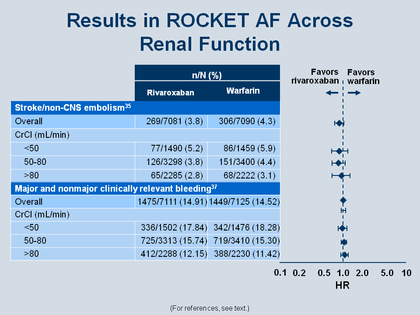James A. Reiffel, MD - Novel Oral Anticoagulants - Figure 42
Rivaroxaban and Renal Function
Since AFib is a disease that occurs disproportionately in the elderly, this means that physicians must often treat patients who will have some degree of renal impairment. The regimen in ROCKET AF was rivaroxaban 20 mg/day, except in cases of renal dysfunction (CrCl 30–49 mL/min), in which case the dose was reduced to 15 mg/day. [116] From the Forrest plot in the Figure, this appears to have been the right approach. The Figure shows outcome events, both stroke and non-CNS embolism, and bleeds, according to renal function and thereby according to dose.[117] So the doses of rivaroxaban that were approved for anticoagulation in patients with nonvalvular AFib were 20 mg once/day for patients with CrCl >50 mL/min and 15 mg once/day for those with impaired renal function (CrCl 15–50 mL/min).
Reiffel JA. Am J Med 2013; 126: 00-00.

